By: Thomas Reilly
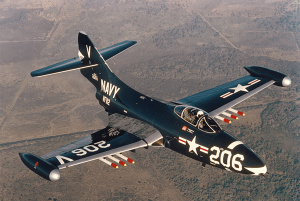
Arthur Alan Wolk’s Grumman F9F-2 Panther BuNo. 123072 Photo Credit: Arthur Alan Wolk
Arthur Alan Wolk is an accomplished pilot and Philadelphia attorney. As the founding partner of the Wolk Law Firm, which specializes in aviation law and in improving air safety, his two great passions are woven together. This is his story…
Mr. Wolk’s involvement in the Warbird community began in 1984 with the purchase of a Korean War era Grumman F9F-2 Panther jet fighter. He says, “I had been a pilot for many years and was interested in flying a Warbird…the Panther became available for sale due to the death of its owner and so I acquired (it)”. At the time this was the only airworthy F9F Panther flying in the world. The aircraft was pieced together using airworthy parts from other F9F airframes in order to piece together one airworthy jet.
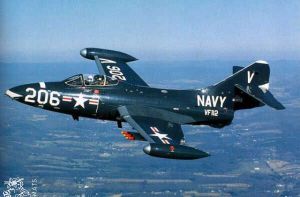
Arthur Wolk’s Grumman F9F-2 Panther in flight.
“I had an F9F -2 Panther,” says Mr. Wolk. “The -2 Panther was the low powered version, so it only had 5,000lbs of thrust. It only remained in Korea and on the ship about six months and it was succeeded by the -5 Panther which had about 6,200lbs of thrust and a larger tail. It was not a totally different animal but, a much better airplane for the use that was intended, a carrier based ground support fighter. The Panther for me was great because it was very easy to fly, not complicated, and you could understand how really young and inexperienced pilots could fly it safely”.
The F9F Panther is a single seat jet fighter and because of this Mr. Wolk had to do his training in other models of jet aircraft. This is unique because typically a pilot would training and receive instruction in the type of aircraft that they would be flying solo for the first time. This is especially true for a pilot making their first solo flight in a jet aircraft but, the Panther did not allow for this. Mr. Wolk initially began training in a De Havilland Vampire with a friend instructing him however, circumstances did not allow him to solo the Vampire before flying the Panther. Mr. Wolk says with excitement in his voice, “my first flight in the Panther was my first solo flight in a jet fighter”. He continues, “It was one of the most harrowing experiences of my life!”. Mr. Wolk explains, “It was a very unfamiliar airplane to me. All of the things I was unfamiliar with for example: the very high weight, the very significant change in the way it flew depending on how much power you used, the incredible fuel consumption. But, very quickly, within a few hours it became really very easy to fly”.
Mr. Wolk’s preparation for his Panther solo is unique. He says, “basically the way I learned how to fly it was Grumman’s chief test pilot, who was at Edwards Air Force base at the time, spoke to me on the phone for about an hour before I flew it and relying on his advice and my own flying experience it became not as big a deal as one would think. Remember every airplane is nothing but a machine. It flies by numbers so, if you’re disciplined to fly by numbers there isn’t any airplane you can’t fly, right?”.
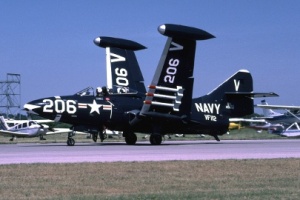
Arthur Wolk’s F9F-2 Panther taxis with wings folded.
After gaining his qualifications and his type certificate in the Panther, Mr. Wolk gradually moved into performing a Panther routine on the airshow circuit. He recalls the flight characteristics of the F9F-2 Panther, fondly noting that the significant difference between the Panther and other jet aircraft is the effect of power. Mr. Wolk explains that, “the aircraft was very sensitive to power adjustments”. He recalls that he always flew that Panther at 92 or 93 percent power. He continues his analysis of the Panther by saying, “I would not call it lively on the controls, it was kinda sluggish. It did have hydraulically boosted ailerons but, other than that it was just pushrods and cables and things like that. It was a fairly primitive airplane for a jet. It was very much like the Grumman propeller airplanes that it succeeded, and it was a jet in the sense that only the powerplant was really different, everything is pretty much the same”. The most significant characteristic however he says was the fuel consumption of the aircraft. The F9F, Mr. Wolk recalls, consumed fuel rapidly and because of this, fuel planning was the most critical responsibility of the pilot. Mr. Wolk says, “I always used about 500 nautical miles as my benchmark and that was if the airplane was fitted out with its six five inch rockets and two five-hundred pound bombs. I mean, without those it had probably another couple hundred mile range”. In cruise, with the rockets and bombs on the wing, the configuration he usually flew in, the Panther could fly at 380 knots and could fly at 425 knots if the weapons were removed.
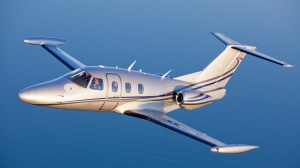
An Eclipse 500 jet similar to what Arthur Wolk currently flies.
Mr. Wolk, who now flies an Eclipse jet, describes the Panther as, “a fighting machine that happened to land and takeoff from aircraft carriers. It was just designed to be relatively easy to fly, be able to carry a combat load, and dispense it and get back to the ship and be able to be strong enough to withstand the beating that, in those days, a carrier landing required”. The Panther, was originally designed to land on straight deck carriers, called “through deck” carriers, and on those carriers there would be airplanes on the far end, there would be a barrier kind of like a big net and there would be the arresting wires at the back of the ship. Obviously you couldn’t land like a real airplane lands or like they currently land otherwise you would be into the barrier and into the airplanes up front. So what would happen is, in the Panther and all aircraft of that vintage, you would approach the ship at an appropriate speed an altitude and the landing signal officer would give you an engine cut, which would be a flag that he would wave horizontally that would indicate to you to cut the power and you literally drop in from 18 feet. So, the airplane had to be really strong and the Panther was extremely strong”.
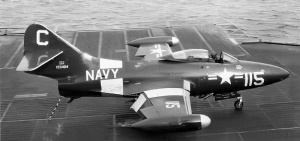
An F9F-2 assigned to VF-21 prepares to trap on the USS Midway in 1952 after flying a sortie over Korea. Photo Credit: U.S. Navy
Arthur Wolk has experienced the short field characteristics of the F9F Panther first hand. He explains that with full fuel tanks, and all of the armament on the aircraft, on a hot day the panther requires approximately 6,000 feet of runway. “You can cut that down a little bit by nursing the airplane aloft”, he says, “but, I think I went into 4,000 maybe, which would have been at the Marine Corps Museum at Quantico, Virginia. That was the shortest field I ever got into or out of. I wouldn’t recommend that to anyone”, he says humbly. It is important to highlight that, at the time of this flight, Mr. Wolk had been flying the Panther for many years and logged hundreds of hours in the cockpit of the F9F. “I knew the airplane like an old shoe by that time so, I knew when it would fly and how it would fly”, Mr. Wolk says. “Basically, I only flew it half full of fuel so I knew I could get off the ground in 4,000 feet”.
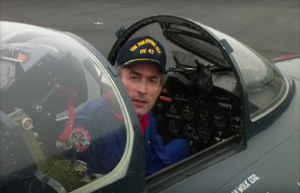
Arthur Alan Wolk sits in the cockpit of his Grumman F9F-2 Panther jet fighter. Photo Credit: EFP Network
“The Panther was unique in a lot of respects”, says Mr. Wolk. “First of all, it was the only one flying. It was a very beautiful airplane, very easy to fly (extremely easy to fly), it was a nice airshow airplane. I did have to have a full time mechanic so that was an issue but, there wasn’t anything unusual about its mechanical features so it wasn’t difficult to keep it maintained. Comparing it to other airplanes, it’s probably more exciting to fly than most although, I fly an Eclipse jet now and in terms of excitement and utility you know the Eclipse jet is much better. In total, Mr. Wolk has logged nearly 350 hours in the F9F-2 Panther. “I think I had more time in the F9F-2 than anybody in the military did. 11 years, I mean nobody in the military flew it for 11 years”, says Mr. Wolk.
Most warbird enthusiasts will admit to being envious of men like Arthur Alan Wolk who have the opportunity to fly unique and historic airframes. Although it is true that when Mr. Wolk flew his F9F -2 Panther, he was the only one in the sky, we must also remember that the spectators at eleven years of air shows were able to see living history and experience his historic aircraft in a way that without his efforts would otherwise not have been possible. Thanks for the ride, Mr. Wolk.



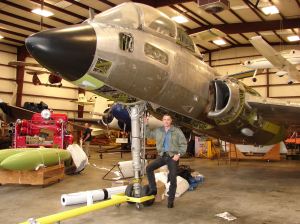
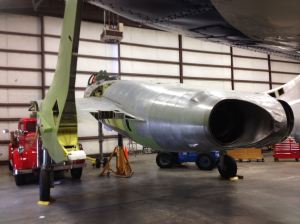



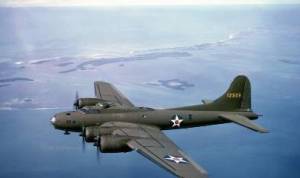
 Hurricane 501 is a British organization that is working to restore Hurricane V7497 a Battle of Britain veteran of 501 Squadron to airworthy condition.
Hurricane 501 is a British organization that is working to restore Hurricane V7497 a Battle of Britain veteran of 501 Squadron to airworthy condition.

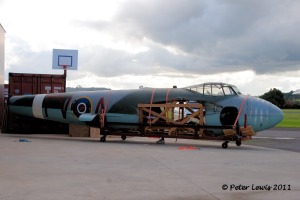


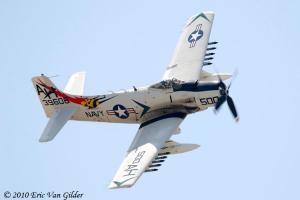

Recent Comments